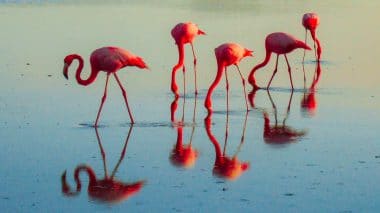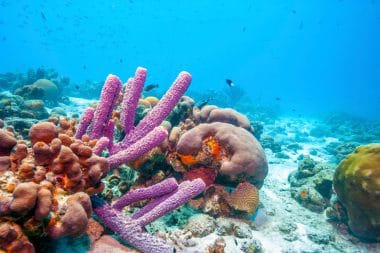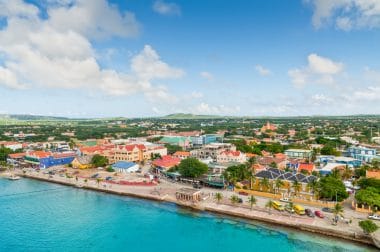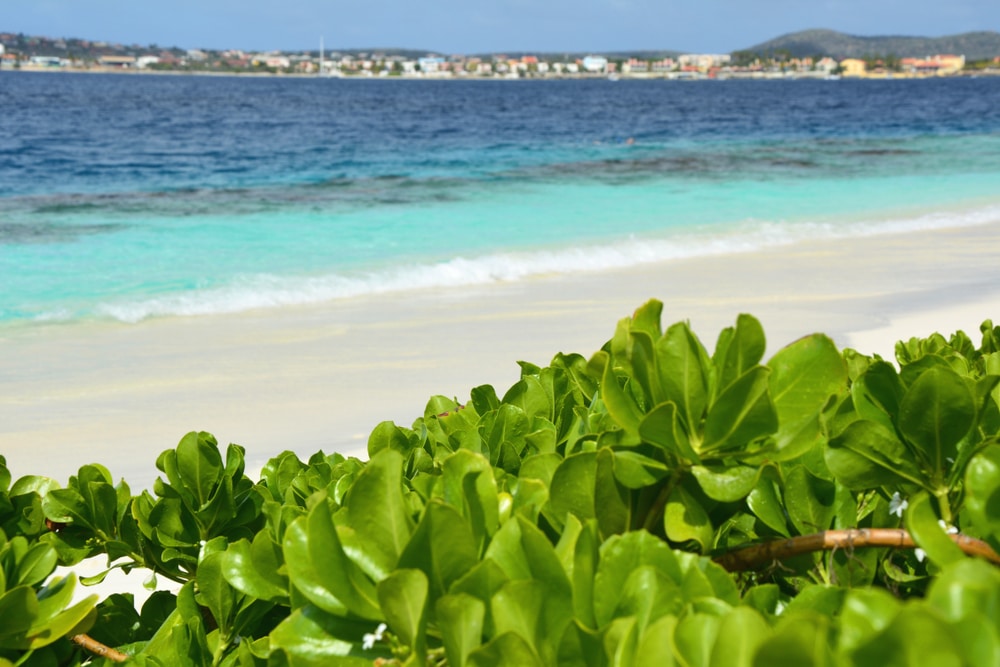Since 2011, the Dutch airline KLM has been offering a daily flight to the island of Bonaire. Before that, the airport of the capital Kralendijk, which means coral dike, was mainly used for stopovers to and from South America and was only served three times a week.
The island, which belongs to the so-called ABC Islands (formerly the Netherlands Antilles) (Aruba, Bonaire and Curacao), can refer to a long-back, albeit not glorious, history. The indigenous people are the Arawak, who still make up a large part of the population today. It also follows that the language used in the main is the “Papiamentu”. However, there are no communication difficulties because of this. Because in addition to Dutch, sufficient English is also spoken. It is assumed that the Arawak settled on Bonaire from other islands.

In the 15th century, the Spanish invaded the island. But since they did not find any other important natural treasures for them apart from salt lakes, they soon left the island again. The French who followed them behaved in the same way. In the following little more than 50 years, the island was mainly used to station prisoners on it, who were mainly employed in mining salt.
The quite large wild donkey herds, which can be spotted especially in the north of the island, probably date back to this time. It was the Dutch who then took the island under their flag. Since the vote in 2011, Bonaire has been counted as a “public body and special community” and as such has been included under Dutch custody.
Politics? Far from it
From a constitutional point of view, the island sees itself as a solitarily administered community, which is administered by nine elders, who make decisions according to the majority principle. This “corps” is also responsible for the execution of the decisions. The council has to deal mainly with nature conservation, compliance with the applicable regulations and the safety of people and nature. It is also a paradise for “politicians”.
Bonaire one of the last paradises?

In fact, it seems that the island does not have much to offer except for herds of donkeys, iguanas and flamingos, both of which are mainly in the much greener and richer north of the island. This is precisely what makes the island in the Caribbean so appealing. The construction of large hotel complexes was prohibited when the marine researcher Hans Hass saw the vulnerability and natural sensitivity under danger if tourism were to be approved to an excessive extent.
Which is why the northwestern part of the island, the “Washington-Slaagbai National Park”, was built and strict guidelines were imposed on the so-called rest of the island regarding the construction of hotel complexes.
In fact, this approach proved to be a blessing for the nature and population of the island, which has just 18,000 inhabitants. Last but not least, the fact that mass tourism can be kept within limits, no other economic achievements have taken place, except for the fact that many bed and breakfasts have been established, which know how to cater for 50,000 divers and other water sports fans, has saved the island from damage. For example, Bonaire was named the 4th best diving area on earth by Forbes Traveller.
Flamingos and other birds of paradise
In addition to the national park located in the northwest of Bonaire, there are two large inland lakes in the north and south of the island. Every year, huge flocks of flamingos gather on it, for which mud nests have been set up here for breeding. A sight that is worth the journey alone.
But Bonaire also serves many other species, especially from the bird world a paradisiacal home. The bird population has settled mainly away from the trade winds that prevail in the northwest of the island. Here, the coast is mainly characterized by rugged rocks. In between, however, as if nature were also concerned about the well-being of swimmers, there are sandy wide bays that invite you to snorkel.
Surfers from all over the world use it. The special clarity and purity of the water and the accompanying underwater fauna and flora, which are unparalleled in their biodiversity, should not go unmentioned. It also seems to be a paradise for the ubiquitous columnar and candelabra cacti, which thrive here as tall as a man and provide shelter for many bird species.
Bonaire – an island of a different kind
If you are looking for variety, discos and other “necessary” entertainment, you will certainly be in the wrong place on Bonaire. Here the visitor has to be satisfied with the two local radio stations that can be received via medium wave. Which does anything but detract from the island in its amazing naturalness.
Instead, the island, where you pay with US dollars despite your Dutch affiliation, offers an almost breathtaking and at the same time paradisiacal tranquility, which is made even more attractive by its natural biodiversity. If you are not afraid of the relatively long journey and are looking for pure nature in all its freshness and purity, you will find what you are looking for on Bonaire.
Sights on Bonaire
Kralendijk

Kralendijk is the capital of Bonaire and also the most important port on the island. If you arrive on a cruise ship, you will meet several shops and tour operators when you leave the ship. This is also where Bonaire’s airport, Flamingo International Airport, is located, which is quite small.
The architecture of the island is very similar to that of Curaçao, very colorful and with Dutch influences. In the capital, you should definitely go shopping, because the shops offer different products for every taste and are tax-free.
Salt Flats
It is not every day to see landscapes colored pink by the sea and salt. This is the case on Bonaire and even if you are not allowed to visit the salt factory, it is still allowed to take photos. This factory has been in existence for more than 350 years. Right next to the salt flats, you can see the beautiful pink waters, which perfectly match the flamingos in the area. From the city center it is about 20 minutes to get there, and the scenery is really breathtaking, it looks like something out of a fairy tale.
The Marine Park of Bonaire
This was proclaimed around the island and designated Bonaire National Marine Park . Rigorous nature conservation policy ensures that the reefs that have built up around the island, home to all kinds of species, can continue to live here protected and safe in the future.
Slave huts
These huts were built in 1850, during the time of slavery, and served as accommodation for the slaves who worked in the salt flats to collect and transport salt, one of Bonaire’s most important export products. These huts served as a place to sleep and to store personal belongings. Every Friday afternoon, the slaves emigrated seven hours from Rincon to spend the weekend with their families, returning on Sunday.
Willemstoren Lighthouse
This 23-meter-high lighthouse was built in 1837, is now decommissioned and stands near Atlantis Beach, practically in the middle of nowhere. In the area, you can only occasionally see a flamingo on the road or wild donkeys.
Donkey sanctuary
Donkey Sanctuary Bonaire is committed to ensuring a safe life for all donkeys on Bonaire. It also provides islanders, schools, and tourists with knowledge about the habitat of this beautiful animal, which has a close history with humans. Currently, more than 600 donkeys are housed there. They are provided with food, drinking water and medicine and enjoy plenty of space and freedom.
Washington Slagbaai National Park
This park is located on the northern tip of Bonaire. It consists of two former plantations, one Washington and the other Slagbaai. These are very extensive and have a total area of about 14,000 hectares. In the past, charcoal, aloe products, dividivi pods and goats as well as salt were grown and refined here for sale to Curaçao and Europe.
The best beaches on Bonaire
- Sorobon: To the east of Bonaire, in the bay of Lac, Sorobon beach is the best recommendation. Sorobon’s private beach has shaded cabanas and sun loungers, and the site offers water sports rentals. The warm, shallow water is the perfect place for the whole family and for windsurfers.
- Coco Beach: Mostly visited by locals, many snorkel here because of the crystal clear waters and low waves. Coco Beach Bonaire is a relatively new beach club (2016) located on a beautiful sandy beach just outside the center of Kralendijk, next to the Spice Beach Club, on the site where the Sunset Beach Resort used to stand.
- Atlantis Beach: The ideal beach for windsurfers because it is so windy. There is a large windsurfing school that rents equipment for the day. The beach is very close to the slave huts, so your beach trip can be combined with a visit to the historic site.
Diving on Bonaire
Bonaire has perhaps the most colorful dive sites in the Caribbean. With about 470 species of fish, you’ll see all the colors of the rainbow here. Bonaire also stands out because there is almost no current in the waters off the island. For this reason, Bonaire is one of the best dive sites in the world to learn to dive, but also to deepen your acquired knowledge. Visitors to Bonaire can choose between boat diving and shore diving. Most hotels score with their own natural house reefs, which are directly accessible from the beach. Most of the diving around Bonaire takes place on the west coast. Advanced divers should explore the dive sites at the northern and southern tip. Although it is a small island, the sea will enchant you with its turquoise to deep blue tones.
Useful Facts
- Language: The most widely spoken languages on Bonaire are Papiamentu, Dutch, and Spanish, with only the first two being official languages.
- Climate: The dry season lasts from February to July and the rainy season from October to December. The average temperature is 29°C.
- Currency: US Dollar ($)
- Easy to get around the island: Golf cart rentals, minibuses and getting around Kralendijk on foot are easy.
- Flights: The most common routes are with Copa with a connection in Panama or with American airlines with a connection in New York to the Antilles.
The most beautiful beaches on Bonaire
- Sorobon Beach – Known for its shallow, turquoise waters, this beach in Lac Bay is a popular spot for snorkeling and windsurfing.
- Klein Bonaire – A small island accessible only by boat, it offers an unspoiled natural environment and breathtaking snorkeling opportunities.
- Pink Beach – Named for the pink sand made up of crushed coral, this beach is a unique place to enjoy the beauty of Bonaire.
- Bachelor’s Beach – A quiet and secluded beach known for its clear waters and the many fish that can be spotted while snorkeling.
- Te Amo Beach – A popular spot for divers known for its large number of colorful corals and fish.
- Donkey Beach – Another secluded beach that offers great views of the ocean and is a great place to relax and snorkel.
- Andrea I and II Beach – Located in the south of Bonaire, these beaches are quiet and peaceful and offer a great opportunity to enjoy the beauty of Bonaire.


